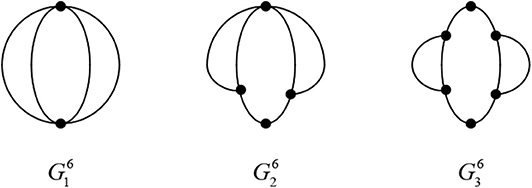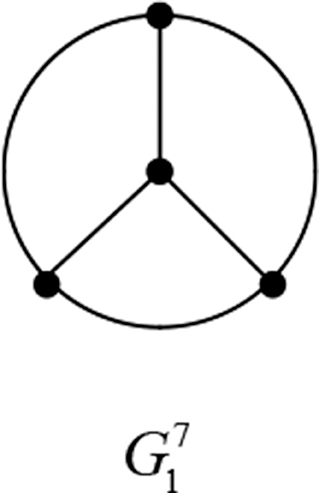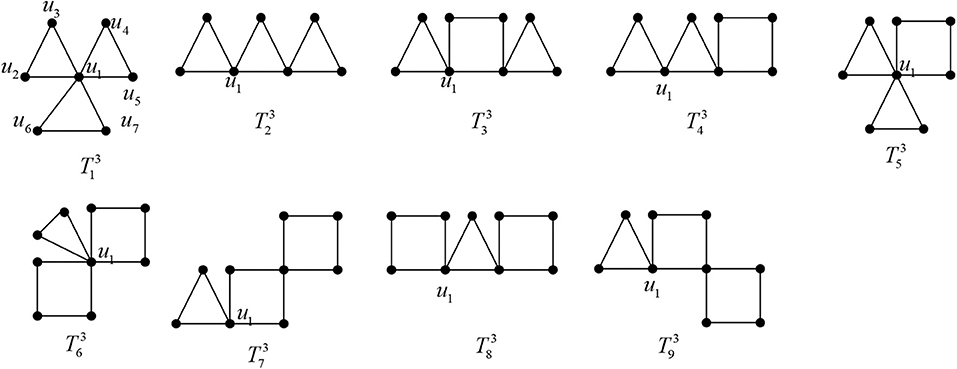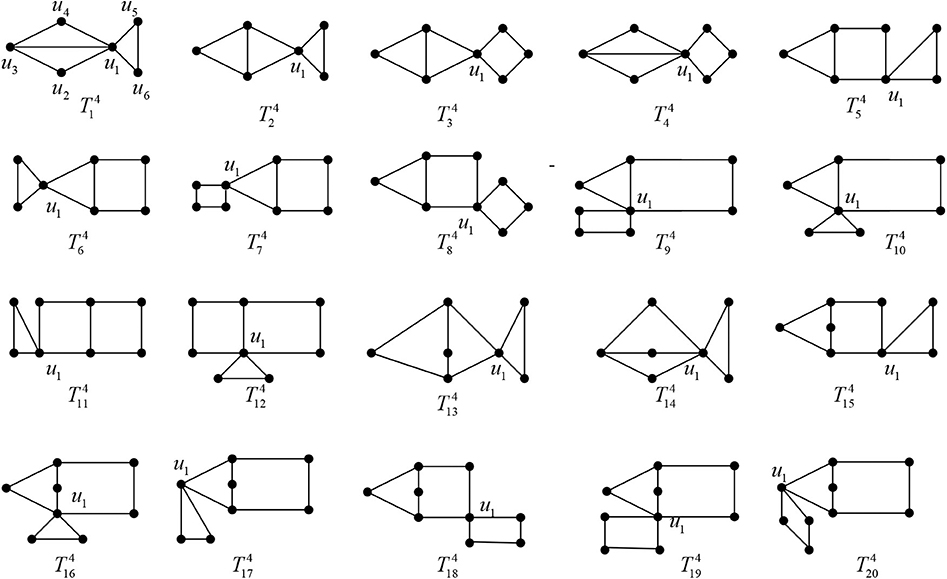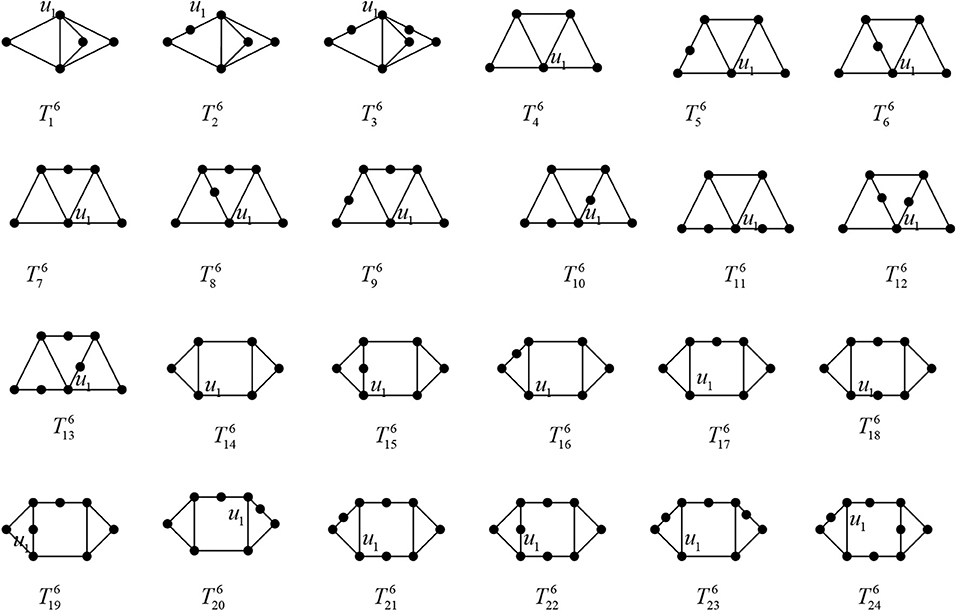- 1College of Science, Xijing University, Xi'an, China
- 2Faculty of Mathematics and Statistics, South Central University for Nationalities, Wuhan, China
With the wide application of graph theory in circuit layout, signal flow chart and power system, more and more attention has been paid to the network topology analysis method of graph theory. In this paper, we construct a graph transformation which can reflect the monotonicity of coefficients and reduce the number of graphs. A sharp lower bound for incidence energy in the tricyclic graphs is given and all the extremal structures are characterized. The most interesting things that we find two different classes tricyclic graphs have the same signless Laplacian characteristic polynomials and one of the extremal graphs beyond all expectations.
1. Introduction
Graph theory is a branch of discrete mathematics, Its research object is abstracted from the actual problem. For example, the geometric structure of an electrical network can be represented as a corresponding line graph. In the graph, the properties of circuit elements are ignored, the length and bending of edges are not important, but the connection between nodes and branches is highlighted. Each element in the network is replaced by a line segment, which is called a branch, and the endpoint of each element or the point connected by several elements is represented by an origin, which is called a node. The set of points and lines is called a network graph and is represented by G. Let G = (V, E) be a simple connected graph with n vertices, m edges [1]. Let Pn, Cn and Sn be the path, the cycle and the star with n vertices, respectively [1]. Let NG(v) = {u|uv ∈ E(G)}, denote by dG(v) = |NG(v)| the degree of the vertex v of G. We know that L(G) = D(G) − A(G) is the Laplacian matrix of G, and A(G) is (0, 1) adjacency matrix, D(G) is degree diagonal matrix. Corresponding to the Laplacian matrix, Q(G) = D(G) + A(G) is called the signless Laplacian matrix of a graph [2]. The Laplacian characteristic polynomials and signless Laplacian characteristic are defined as the following
For G, H, if ci(G) ≤ ci(H),i = 1, 2, …, n, we call that G ≼′ H. If φi(G) ≤ φi(H), i = 1, 2, …, n, we call that G ≼ H [3, 4].
Denote by n,m the set of simple connected graphs of order n and size m. If m = n − 1 + c, G denotes a c-cyclic graph. If c = 0, 1, 2, and 3, G represents a tree, unicyclic graph, bicyclic graph and tricyclic graph, respectively [1]. Recently, with further research on the power system network, the study of the structure and properties of the partial ordering sets and (n,m, ≼) have attracted much attention. For m = n − 1, Mohar [5] proved that there is unique maximal element and unique minimal element in . Since L(G; λ) = Q(G; λ) for bipartite graph, then (n,n − 1, ≼) has the same structure and properties as . For m = n, Stevanović and Ilić [6] showed that there is also unique maximal element and unique minimal element in . But for (n,n, ≼), Li et al. [7] given the extremal elements in (n,n, ≼). He and Shan [8] obtained the unique minimal element in , and in Zhang and Zhang [3], two minimal elements in (n,n + 1, ≼) were determined by Zhang and Zhang. For simplicity, denote the class of connected tricyclic graphs order n, i.e., n,n + 2 by n [9]. Pai et al. [10] characterized the unique minimal element in . Based on these works, we focus on the structure and properties of the partial ordering sets (n, ≼).
2. Preliminaries
In this section, we introduce some graphic transformations and lemmas, which will be used to prove our main results.
If a connected graph has only one cycle whose length is odd, the graph is odd unicyclic. If the components of a spanning subgraph of G are trees or odd unicyclic graphs, the subgraph is called a TU-subgraph of G [3]. Let H be a TU-subgraph of G, which contains c odd unicyclic graphs and s trees T1, …, Ts of orders n1, …, ns, respectively. So the weight of H . If there contains no tree in H, so ω(H) = 4c. If H is empty graph,there is no H, so ω(H) = 0. We can express the signless Laplacian coefficients φi(G) by the weight of TU-subgraphs of G [11].
Lemma 2.1. [12] Let be the characteristic polynomial of the signless Laplacian matrix of a graph G of order n. Then , i = 1, …, n, where the summation runs over all TU-subgraph Hi of G with i edges.
Definition 1. [8] Let G be a simple connected graph with n vertices and uv be a non-pendent edge, which is not contained in any cycles of G. Let Guv = G − {vx|x ∈ NG(v)\{u}} + {ux|x ∈ NG(v)\{u}}. We say that Guv is an α-transformation of G.
Lemma 2.2. [3] Let G be a connected graph of order n ≥ 4, and Guv be obtained from G by α-transformation. Then Guv ≼ G, i.e., φi(Guv) ≤ φi(G), i = 0, 1, …, n, with equality if and only if either i ∈ {0, 1, n} when G is non-bipartite, or i ∈ {0, 1, n − 1, n} for otherwise.
The proof of the following lemma can be found in many places in the literature (see, such as [13]).
Lemma 2.3. [14] L(G; λ) = Q(G; λ) if and only if the graph G is bipartite.
Lemma 2.4. [15] Let f(λ) and g(λ) be two real polynomials arranged according to decreasing exponents. If their coefficients are alternate about positive and negative, then the coefficients of f(λ)g(λ) also are alternate about positive and negative.
Let G be a connected graph with at least one cycle, the base of G is represented by , which is the minimal connected subgraph containing all the cycles of G [16]. So is the unique subgraph of G, which contains no pendant vertex. G can be obtained from by planting trees to some vertices of [17]. Hoffman and Smith [18] define an internal path of G as a walk u0u1…us(s ≥ 1),and the vertices u0, u1, …, us − 1 are distinct, d(u0) > 2, d(us) > 2, and d(ui) = 2, whenever 0 < i < s. An internal path is closed, if u0 = us.
Definition 2. [19] Let G = (V, E) be a connected graph and the base of G is . Let u, v, w be three consecutive vertices in an internal path of length at least 4 of , which satisfy NG(u) ∩ NG(v) = ∅, NG(w) ∩ NG(v) = ∅ and NG(u) ∩ NG(w) = {v}. We can delete all edges vz for z ∈ NG(v)\{u, w}, wz for z ∈ NG(w) and add all edges uz for z ∈ (NG(v) ∪ NG(w))\{u, v} from G and get the graph G′(u, v, w). G to G′(u, v, w) is called a β-transformation of G.
Lemma 2.5. Let G = (V, E) be a connected graph and the base of G is . Let u, v, w be three consecutive vertices in an internal path of length at least 4 of , and G′(u, v, w) be a graph obtained from G by β-transformation [19]. So G′(u, v, w) ≼ G, that is, for i ∈ {0, 1, 2, …, n}, with equality if and only if i ∈ {0, 1} when G is non-bipartite, and i ∈ {0, 1, n} when G is bipartite.
Proof: and . Moreover, for bipartite graph. Now assume that 2 ≤ i ≤ n. Let and be the set of all TU-subgraphs of G′(u, v, w) and G with i edges, respectively. For an arbitrary TU-subgraph H′ ∈ , denote by the R′ connected component of H′ containing u [3]. Let f : → with H′ → H = f(H′), where V(H) = V(H′) and
Then f is injective from → .
Case 1. u, v, w belongs the component S′. So f(S′) is a component of H, which in the same order as S′. Then ω(H) = ω(H′).
Case 2. u, v, w belong to at least two components of H′.
Case 2.1. u is not in an odd unicyclic component of H′. Then u is contained in a tree component of H′. Assume that there exist x1 + 1 vertices in the connected component which contains u in H − uv [3], x2 + 1 vertices in the connected component which contains w in H − wv and x3 + 1 vertices in the connected component which contains v in H − uv − vw, where x1, x2, x3 ≥ 0. Let N indicate the weight of the components of H′, which contain no u, v, w.
(i) If uv ∈ E(H′)anduw ∉ E(H′), then
(ii) If uv ∉ E(H′)anduw ∈ E(H′), then
(iii) If uv ∉ E(H′)anduw ∉ E(H′), then
Case 2.2. u is in an odd unicyclic component S′ of H′. Let C′ be a subgraph of S′, which corresponds to an odd cycle C in G.
(i) If uv ∉ E(H′), uw ∉ E(H′), and C = C′, let S be the component containing C in H. So there are the same components in H′ and H, except for S′, {v}, {w} in H′, which correspond to the component S containing u, two components S1 containing v and S2 containing w of order at least 1, respectively, in H. If uv ∉ E(H′), uw ∉ E(H′), and C ≠ C′. So there are the same components in H′ and H, except for S′, {v}, {w} in H′, which correspond to two tree components S1 containing u, w of order at least 4 since u, v, w are three consecutive vertices in an internal path of length at least 4 of , and S2 containing v of order at least 1, in H. So
(ii) If uv ∉ E(H′), uw ∈ E(H′) or uv ∈ E(H′), uw ∉ E(H′), and C = C′, So there are the same components in H′ and H, except for S′, {v} or {w} in H′, which correspond to an odd unicyclic component S containing C and a tree component S1 containing v, w of order at least 2. So
If uv ∉ E(H′), uw ∈ E(H′) or uv ∈ E(H′), uw ∉ E(H′), and C ≠ C′, So there are the same components in H′ and H, except for S′, {v} or {w} in H′, which correspond to a tree component S containing u, v, w of order at least 5. So
Then by Lemma 2.1, we have
Hence the results hold.□
Similarly, we can prove the following result.
Lemma 2.6. [19] Let G = (V, E) be a connected graph with base . Let u, v, w be three consecutive vertices in an internal path P = u1u2…uk with k = 4 of and . Let G′(u, v, w) be a graph obtained from G by β-transformation, then G′(u, v, w) ≼ G, that is, for i ∈ {0, 1, 2, …, n}, with equality if and only if i ∈ {0, 1} when G is non-bipartite, and i ∈ {0, 1, n} when G is bipartite.
By Li et al. [20], There are the following four types of bases in tricyclic graphs(as shown in Figures 1–4): and . Let
Then
Let and be the graphs as shown in Figure 5.
Lemma 2.7. [10]
(i) If , then for every i = 0, 1, …, n, , with equality if and only if i ∈ {0, 1, n}.
(ii) If , then for every i = 0, 1, …, n, , with equality if and only if i ∈ {0, 1, n}.
(iii) If , then for every i = 0, 1, …, n, , with equality if and only if i ∈ {0, 1, n}.
(iv) If , then for every i = 0, 1, …, n, , with equality if and only if i ∈ {0, 1, n}.
For i = 3, 4, 6, 7, let (resp., ) be the set of bipartite tricyclic graphs (resp., non-bipartite tricyclic graphs) in , then . From lemmas 2.3 and 2.7, we get
Corollary 2.8. [10]
(i) If , then for every i = 0, 1, …, n, , with equality if and only if i ∈ {0, 1, n}.
(ii) If , then for every i = 0, 1, …, n, , with equality if and only if i ∈ {0, 1, n}.
(iii) If , then for every i = 0, 1, …, n, , with equality if and only if i ∈ {0, 1, n}.
(iv) If , then for every i = 0, 1, …, n, , with equality if and only if i ∈ {0, 1, n}.
Theorem 2.9. [10] Let G be a connected tricyclic graph on n vertices and i be an integer, 0 ≤ i ≤ n. Then .
Repeated by lemmas 2.2, 2.5, and 2.6, we get the following conclusion
Theorem 2.10. Let G be a graph in . So there is a tricyclic graph G′ with order n, such that G′ ≼ G,. The base of G′ is one of graphs in (these base graphs are as shown in Figures 7–9.
3. The Signless Laplacian Coefficients of Graphs in Tn
Now we consider the minimal element in the partial ordering set (n, ≼).
For i = 1, 2, …, 9, let be the graph obtained from (as shown in Figure 6) by attaching sj pendent edges at , where .
Lemma 3.1. For j = 1, 2, …, 9, , that is, The equality holds if and only if .
Proof: For convenience, let and for j = 1, 2, …, 9. Note that . For 2 ≤ i ≤ n, let and be the set of all TU-subgraphs of G′ and G with exactly i edges, respectively [3]. Let
Similarly for (1), (2), and (3). We only prove the case for j = 1, the others can be proved similarly.
Let f : → with H′ → H = f(H′), where V(H) = V(H′) and
for R′ being a component of H′ containing u1. Obviously, f is injective and f(′(k)) ⊆ (k) for j = 1, 2, 3. From the procedure of proof in Theorem 3.1 [10], we have
Note that ′(3) = ∅ for j = 1. For H′ ∈ ′(2), without loss of generality, we assume that R′ contains C3 = u1u2u3u1 as a subgraph. Let R be the component of H corresponding to R′, obviously, R also contains C3 = u1u2u3u1. It is obvious that H′, H have the same number of components and the product of the order of components which contain no ui(i = 1, 2, …, 7) of H′ is the same as H. The order of the tree components of H′, which include at least one of ui(i = 4, …, 7) are no more than the corresponding ones of H, then ω(f(H′)) ≥ ω(H′). Hence
The equality holds if and only if s2 = ⋯ = s7 = 0.□
For i = 1, 2, …, 20, let be the graph obtained from (as shown in Figure 7) by attaching sj pendent edges at , where . Similar to the proof of Lemma 3.1, we have
Lemma 3.2. For j = 1, 2, …, 20, , that is, The equality holds if and only if .
For i = 1, 2, …, 7, let be the graph obtained from (as shown in Figure 8) by attaching sj pendent edges at , where . Similar to the proof of Lemma 3.1, we have
Lemma 3.3. For j = 1, 2, …, 7, , that is, The equality holds if and only if .
For i = 1, 2, …, 24, let be the graph obtained from (as shown in Figure 9) by attaching sj pendent edges at , where . Similar to the proof of Lemma 3.1, we have
Lemma 3.4. For j = 1, 2, …, 24, , that is, The equality holds if and only if .
Lemma 3.5. For ,
(i) .
(ii) for j = 3, 4.
(iii) for j = 7, 8, 9.
Proof: (i) We have
Further by Lemma 2.3, .
So (ii) and (iii) hold.□
Lemma 3.6. For ,
(i) for j = 2, 5, 6, 10, 15, 16, 17
(ii) for j = 3, 7, 8, 9, 18, 19, 20.
(iii) for j = 11, 12, 13.
Proof:
By the results of Appendix, the results hold.
Lemma 3.7. For , .
Proof: We have
So the results hold.□
Theorem 3.8. For , . The equality holds if and only if
Proof: If , by Theorem 2.9, the results hold.
If , by direct calculation, we have
Further by Theorem 2.10 and lemmas 3.2–3.4, 3.6–3.8, we have .□
Lemma 3.9. For , .
Proof: We have
By the results of Appendix, the results hold.□
Theorem 3.10. For , or . The equality holds if and only if or
Proof: If , by Theorem 2.9 and
we have .
If , by Theorem 2.10, lemmas 3.5 and 3.9, we have or .□
Remark: By (3.1), and have the same signless Laplacian characteristic polynomials.
Theorem 3.11. are the only three minimal elements in the partial set (n, ≽).
Proof: By (3.1), theorems 3.8 and 3.10, it is obvious that are the minimal elements in the partial set (n, ≽).
Note that if there is a graph G0 in such that , then by Theorem 3.8 and (3.1), we have But
it is a contradiction.
Hence the results hold.□
4. The Incidence Energy of Tricyclic Graphs
The incidence energy IE(G) of a graph G is defined to be the sum of the square root of all eigenvalues of Q(G)[3].
Theorem 4.1. [11] Let G and G′ be two graphs of order n, if for 1 ≤ k ≤ n, then IE(G) ≤ IE(G′). In particular, if at least one of inequalities is strict, then IE(G) < IE(G′).
Theorem 4.2. If G ∈ n, then The equality holds if and only if or
Proof: By Theorem 3.11, we have
Note that
Let α1 ≥ α2 ≥ α3 be the roots of x3 − (n + 5)x2 + 5nx − 12 = 0, and β1 ≥ β2 ≥ β3 ≥ β4 ≥ β5 be the roots of x5 − (n + 9)x4 + (11n + 19)x3 − (41n − 19)x2 + (58n − 64)x − 22n = 0, then
If n ≤ 40, by Matlab7.0 it is easy to see holds.
If n ≥ 40, it is easy to see that n − 0.07 ≤ α1 ≤ n + 0.07, 4.93 ≤ α2 ≤ 5, 0 ≤ α3 ≤ 0.07 and n − 1.98 ≤ β1 ≤ n − 1.9, 4.58 ≤ β2 ≤ 4.62, 3.41 ≤ β3 ≤ 3.42, 2.37 ≤ β4 ≤ 2.39, 0.54 ≤ β5 ≤ 0.55.
It is easy to see that
So the assertions hold.□
5. Conclusion and Extension
This paper propose an appropriate graph transformation to reflect the monotonicity of the coefficients, and give a sharp lower bound for incidence energy in the class of tricyclic graphs and characterize the extremal structures. The study on boundary of the incidence energy and its extremum structure of tricyclic graphs enriches and develops the study of the graph structure, but also connects the mathematical branch with other disciplines such as biology, physics and chemistry. It promotes the development of some theories of graph theory. It promotes the development of graph structure, the development of graph theory, and the study of graph theory and its application. For example, mathematical biology, application of graph theory in power system, molecular structure based on graph theory. Furthermore, similar to the graph energy, the incidence energy also reflects some physical and chemical properties of conjugated molecules, such as melting point and boiling point, this provides a theoretical reference for the researchers of the synthesis of new materials and new materials, and saves the cost for the development of new materials and new materials to a certain extent. Based on the extensive application of graph theory in many fields, the findings of this study have many important implications for future practice.
Data Availability Statement
The original contributions presented in the study are included in the article/Supplementary Materials, further inquiries can be directed to the corresponding author/s.
Author Contributions
ZZ contributed to the conception of the study, performed the data analyses, and wrote the manuscript. HL contributed significantly to analysis and manuscript preparation and helped to perform the analysis with constructive discussions.
Funding
This work was supported by the Scientific Research Project of Education Department of Shaanxi Province (19JK0906).
Conflict of Interest
The authors declare that the research was conducted in the absence of any commercial or financial relationships that could be construed as a potential conflict of interest.
Supplementary Material
The Supplementary Material for this article can be found online at: https://www.frontiersin.org/articles/10.3389/fphy.2020.00208/full#supplementary-material
References
1. Bollobás B. Modern Graph Theory. Berlin; New York, NY: Springer-Verlag (1998). doi: 10.1007/978-1-4612-0619-4
2. Cvetković D, Simić S. Towards a spectral theory of graphs based on the signless Laplacian. Int Publ Inst Math. (2009) 85:19–33. doi: 10.1016/j.laa.2009.05.020
3. Zhang J, Zhang X. The signless Laplacian coefficients and incidence energy of bicyclic graphs. Linear Algebra Appl. (2013) 439:385–6. doi: 10.1016/j.laa.2013.10.026
4. Lin HQ, Hong Y, Shu JL. Some relations between the eigenvalues of adjacency, Laplacian and signless Laplacian mattrix of a graph. Graphs Combin. (2015) 31:669–71. doi: 10.1007/s00373-013-13980-5
5. Mohar B. On the Laplacian coefficients of acyclic graphs. Linear Algebra Appl. (2007) 722:736–41. doi: 10.1016/j.laa.2006.12.005
6. Stevanović D, Ilić A. On the Laplacian coefficients of unicyclic graphs. Linear Algebra Appl. (2009) 430:2290–300. doi: 10.1016/j.laa.2008.12.006
7. Li HH, Tam BS, Su L. On the signless Laplcaian coefficients of unicyclic graphs. Linear Algebra Appl. (2013) 439:2008–28. doi: 10.1016/j.laa.2013.05.030
8. He CX, Shan HY. On the Laplacian coefficients of bicyclic graphs. Discrete Math. (2010) 310:3404–12. doi: 10.1016/j.disc.2010.08.012
9. Zhu ZX, Lu HY. On the general sun-connectivity index of tricyclic graphs. J Appl Math Comput. (2016) 51:177–88. doi: 10.1007/s12190-015-0898-2
10. Pai X, Liu S, Guo J. On the Laplacian coefficients of tricyclic graphs. J Math Anal Appl. (2013) 405:200–8. doi: 10.1016/j.jmaa.2013.03.059
11. Mirzakhah M, Kiani D. Some results on signless Laplacian coefficients of graphs. Linear Algebra Appl. (2012) 437:2243–51. doi: 10.1016/j.laa.2012.05.022
12. Liu JB, Zhao J, Cai Z. On the generalized adjacency, Laplacian and signless Laplacian spectra of the weighted edge corona networks. Phys A. (2020) 540:123073. doi: 10.1016/j.physa.2019.123073
13. Merris R. Laplacian matrices of graphs. Linear Algebra Appl. (1994) 197–8:143–76. doi: 10.1016/0024-3795(94)90486-3
14. Cvetković D, Rowlinson P, Simić S. Singless Laplacians of finite graphs. Linear Algebra Appl. (2007) 432:155–71. doi: 10.1109/ICACIA.2010.5709937
15. Tan SW. On the Laplacian coefficients of unicyclic graphs with prescribed matching number. Discrete Math. (2011) 311:582–94. doi: 10.1016/j.disc.2010.12.022
16. Hoffman AJ, Smith JH. On the spectral radii of topologically equivalent graphs. In: Fiedler, Editor. Recent Advances in Graph Theory. New York, NY: Academia Praha (1975). p. 273–81.
17. Guo S. On the spectral radius of bicycle graphs with n vertics and diameter d. Linear Algebra Appl. (2007) 422:119–32. doi: 10.1016/j.laa.2006.09.011
18. Tan SW. On the Laplacian coefficients and Laplacian-like energy of bicyclic graphs. Linear Multilin AlgebRA. (2012) 60:1071–92. doi: 10.1080/03081087.2011.643473
19. Wang WH, Zhong L, Zheng LJ. The signless Laplacian coefficients and the incidence energy of the graphs without even cycles. Linear Algebra Appl. (2019) 563:476–93. doi: 10.1016/j.laa.2018.10.025
Keywords: incidence energy, extremal graph, tricyclic graph, Laplacian matrix, signless Laplacian coefficients
Citation: Lu H and Zhu Z (2020) On the Boundary of Incidence Energy and Its Extremum Structure of Tricycle Graphs. Front. Phys. 8:208. doi: 10.3389/fphy.2020.00208
Received: 20 March 2020; Accepted: 15 May 2020;
Published: 19 June 2020.
Edited by:
Muhammad Javaid, University of Management and Technology, PakistanReviewed by:
Sunil Kumar, National Institute of Technology, Jamshedpur, IndiaBoyi He, Sichuan Normal University, China
Zixuan Yang, Xi'an Jiaotong University, China
Copyright © 2020 Lu and Zhu. This is an open-access article distributed under the terms of the Creative Commons Attribution License (CC BY). The use, distribution or reproduction in other forums is permitted, provided the original author(s) and the copyright owner(s) are credited and that the original publication in this journal is cited, in accordance with accepted academic practice. No use, distribution or reproduction is permitted which does not comply with these terms.
*Correspondence: Hongyan Lu, bGh5eTExNkAxNjMuY29t; Zhongxun Zhu, enp4dW43M0AxNjMuY29t
 Hongyan Lu
Hongyan Lu Zhongxun Zhu
Zhongxun Zhu

